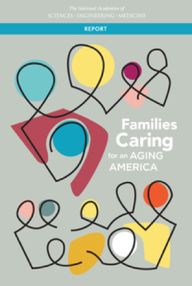Our mission at West Health is to enable seniors to successfully age in place, with access to high-quality, affordable health and support services that preserve and protect their dignity, quality of life and independence.

This is a daunting but worthwhile mission because too many in our growing senior population are forced to choose among basic human needs such as food, medicine and housing, and have difficulty navigating a complex healthcare system that is simply not structured to meet their needs. America’s seniors deserve our help.
The good news is that in 2016, successful aging took on greater urgency and prominence on the national agenda as a rapidly growing senior population began to touch every aspect of life and culture from healthcare to the economy to the communities in which we live.
Here are four important and positive developments from 2016 that will extend beyond the New Year and help make successful aging a reality for all Americans.
1. Reauthorization of Older Americans Act
In April, the Older Americans Act (OAA) was reauthorized, providing funding for essential services and programs that help seniors stay healthy and independent. First enacted in 1965, the OAA supports a range of home and community-based programs, such as Meals on Wheels; in-home, transportation and legal services; elder abuse prevention and caregiver support.
In addition to extending the Act’s core programs, newly-added provisions strengthen elder abuse protections, support oral healthcare screenings among seniors and promote the modernization of senior centers. The OAA increases funding by six percent over the next three years.
In a statement issued when the OAA was signed into law, Kathy Greenlee, Assistant Secretary for Aging with the Department of Health and Human Services, said, “The OAA underpins a promise to preserve the right to live independently, with dignity, making everyday decisions according to our individual preferences and goals across our lifespan.”
2. Senior-Specific Models of Care
In 2016, there was increasing attention on creating and supporting new models of care that better and specifically address the more complex healthcare and social support needs of older adults.
The Rise of the Geriatric Emergency Department
Seniors account for about 17 percent of all emergency visits and approximately 43 percent of hospitalizations originating from the emergency department, a number that is only expected to increase with the aging of America.
In response, greater emphasis is being placed on developing senior-specific care protocols in the emergency room that improve care and utilize home and community-based care options, instead of hospitalization, whenever possible. Enhanced services include comprehensive screenings, case management and social and psychiatric care from a multidisciplinary team of health professionals specially trained in providing care to seniors.
This year, West Health founders and philanthropists Gary and Mary West provided $11.8 million to the University of California San Diego Health System to create a state-of-the-art emergency care unit that will offer enhanced care for older adults and enable a multi-year medical research initiative in partnership with the West Health Institute. The Gary and Mary West Senior Emergency Care Unit will open in 2018 in what will be the first of its kind in the state of California.
Greater Focus on Senior Oral Health
Another model of care, though one that has been slower to catch on than geriatric emergency departments, is dental care for seniors, which is a significant public health issue and unmet need. Millions of people 65 and older are living with untreated cavities, tooth decay, gum disease, oral pain, and tooth loss due to limited or no access to basic dental care.
In December, Health Affairs dedicated an entire issue to “Oral Health & More.” One of the studies featured new research from the Johns Hopkins Bloomberg School of Public Health that suggested only 12 percent of older Americans have some form of dental insurance and fewer than half visited a dentist in the previous year. Medicare, the largest health provider for seniors, does not cover routine dental care, though some Medicare Advantage plans offer the option.

Because of this epidemic of poor oral health in seniors, we opened the Gary and Mary West Senior Dental Center in October. This new center links high-quality and affordable oral healthcare with a suite of nutrition, case management and wellness services offered within a senior wellness center, creating a one-of-a-kind, integrated community-based system of care for older adults. We will be sharing best practices and outcomes data so that more communities and policymakers across the country could turn this into a national model.
3. House Calls
Home-based healthcare models are critical to aging in place, improving health outcomes and better managing healthcare costs, but availability is currently limited. The good news is home-based healthcare took a step forward this year with the success of a Medicare program known as Independence at Home (IAH).
IAH is a demonstration program that provides a full range of primary care services in the home setting. In the program’s first year, 17 practices successfully cared for more than 8,400 patients in their homes with savings totaling more than $25 million – an average of over $3,000 per beneficiary. Now lawmakers are considering making IAH a permanent benefit. Expect more action on IAH legislation in 2017.
4. Family Caregivers
In September, the National Academies of Sciences, Engineering and Medicine issued a major report entitled, “Families Caring for an Aging America.” The report was done at the request of 13 private foundations including The John A. Hartford Foundation, as well as the U.S. Department of Veterans Affairs, who wanted recommendations for addressing the needs of family caregivers and minimizing the barriers they face in trying to meet the needs of older adults.

The report describes the critical role family caregivers play in providing health and medical care at home, navigating the healthcare and long-term services and support systems, and serving as decision makers for ailing loved ones. It says, “The need to recognize and support caregivers is among the most significant overlooked challenges facing the aging U.S. population, their families and society.”
The report calls for reform of our healthcare delivery system in a way that elevates family-centered care alongside person-centered care to better account for the roles of family caregivers and support their involvement in the care delivery process.
The report lays the groundwork for actions necessary to support the estimated 17.7 million people providing care and support for someone 65 and older, a number that grows larger every day. The time for action on this is now and the report is a must-read for policymakers, healthcare providers and community-based organizations.
There is a need to build on the progress of 2016 and never take for granted our nation’s seniors. Growing older is a gift. Visit West Health for more information.
